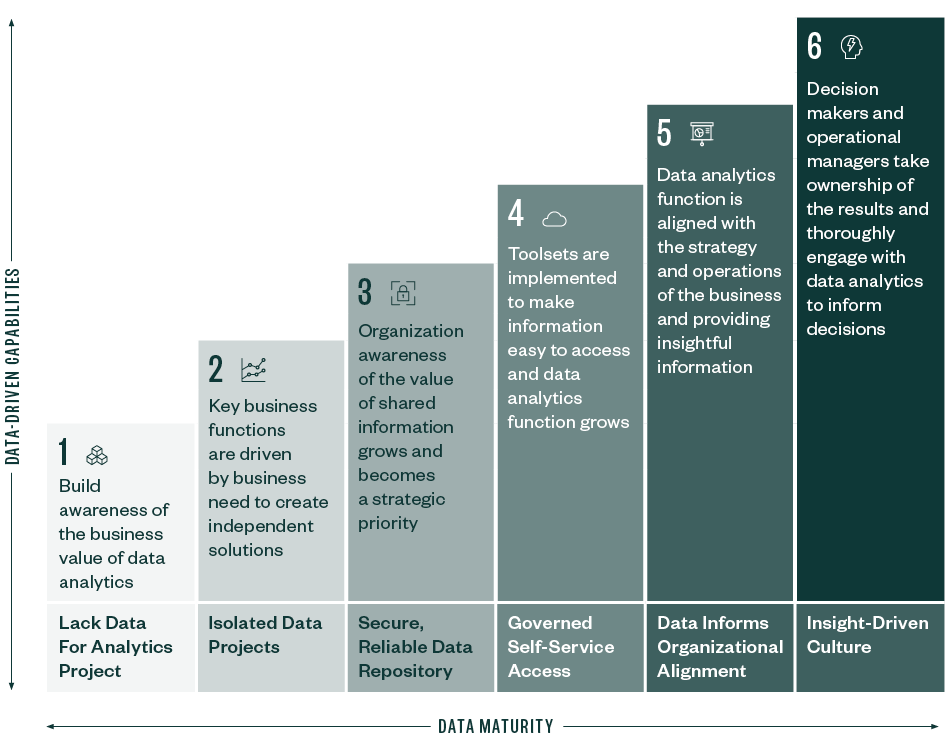
This article was updated October 27, 2022.
Using data analytics for your business can drive significant value and agility. Access to organized, readily available, and updated data can allow you to gain insight into emerging trends to make quick and informed decisions. Executives and managers can better strategize when they have data available.
With the right tools and engaged employees, you can make informed decisions to help manage trends and challenges—at whatever stage your business is with data analytics.
Six Stages of Data Analytics Integration and Utilization
There are six stages along the data maturity curve an organization might go through on the way to becoming data driven:

1. Not Enough Data for Analytics Projects
Organizations at the beginning of the process and lacking insight into their data can start by building awareness of the business value of data analytics. They should be able to articulate the importance of data and what questions around their business they’re seeking to answer.
2. Isolated Data Projects
In stage two, key business functions are driven by a need to create independent solutions. Teams pull data from source systems and use spreadsheets to compile, clean, and understand the data, then prepare outputs.
This stage is often inefficient and prone to errors and siloing. Auditing your current structure could provide a road map to help your organization move out of the heavy lifting stage toward a successful data-driven model.
A data analytics audit could help your organization:
- Determine how ready you are to move away from spreadsheets
- Identify areas where you spend the most time and opportunity costs to prepare spreadsheets
- Identify if your current spreadsheet system could move to a more automated process
3. Secure, Reliable Data Repository
Organization awareness of the value of shared information increases and becomes a strategic priority in stage three.
Organizations are in the emergent stage when:
- Data warehouses have been built
- Many of the reports are automated and can be emailed on a scheduled or real-time basis
- A data governance model and a data culture have been established
- Data is used to drive decisions rather than gut feelings
4. Governed Self-Service Access
Toolsets are implemented to make information easy to access and the data analytics function grows. Approved data sets supply answers to business questions.
5. Data Informs Organizational Alignment
The data analytics function is aligned with business strategy and operations, providing insightful information. Stakeholders can use analytics to generate returns.
6. Insight-Driven Culture
In this stage, decision makers and operational managers take ownership of the results and thoroughly engage with data to inform decisions.
This stage is the highest level of data integration and utilization. Businesses with optimized data analytics processes continuously look for areas of improvement and run more efficiently.
Businesses with an insight-driven culture:
- Use predictive data analytics
- Establish strong forecasting models
- Run what-if scenarios
- Monitor the effectiveness of processes and strategies
- Adjust and fine tune the strategy based on data
Engaged Executives
Before the end of the period your organization has time to analyze current data and determine whether you’re going to meet goals. This leaves you time to see and react to emerging trends and engage in the conversation.
Executives and managers can have productive meetings using current data and formulate a strategy. Engaged executives can fuel an insight-driven culture.
Engage With Data to Recognize and Stay Ahead of Trends
Emerging trends can be difficult to identify if you don’t regularly analyze your data.
You want data in front of you as early as possible to recognize trends as they develop in order to be proactive rather than reactive after they impact operations.
Regularly analyzing your data can help your business:
- Manage volatility
- Navigate complexity
- Manage business performance
- Embrace disruption
An organization might expect an epiphany when analyzing data, but incorporating data analytics is a gradual process. As data is gathered and compiled, trends may emerge that had gone unnoticed. In an engaged organization, managers evaluate and adapt strategy continuously.
We’re Here to Help
For help assessing your current data structure and implementing more robust data analytics platforms and processes, contact your Moss Adams professional.
You can also visit our Data Analytics Consulting Services page for additional resources.